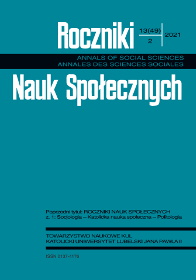The Military Deterrence and Strategic Resilience Within the Nato North-Eastern Flank
Abstract
The threats to European security have become the subject of discussions and actions taken by states and NATO because of using military forces Russia’s to change state borders after 2008. In response to the new situation, deterrence, building national and strategic resilience to military and non-military threats have gained importance again. It was especially true regarding NATO’s eastern flank as being directly threatened by the possibility of hybrid and potentially military engagements. The article aims to present the implementation of deterrence and strategic resilience concepts, especially concerning the activities of NATO and the Baltic countries. A preliminary assessment shows that the arrangements are adequate but require further actions and investments. The article was developed utilizing qualitative methods of analysis, synthesis and case study referring to the theory and practice of the deliberated issues.
References
Anon (October, 2016), Lithuanian Guerrilla Warfare Manual – Translated to English, Vilnius: Ministry of Defence.
Antczak A., Śliwa Z. (2018), Security dilemmas of the Baltic region, Środkowoeuropejskie Studia Polityczne, nr 3 , s. 119-134.
Baltic News Service (2021a), Estonia: National defense camps will be organized by the Defense League, Tallinn.
Baltic News Service (2021b), Herem: Estonia, Switzerland complement each other in field of reserve army, Tallinn.
BNS (2021), Spring Storm 2021 focused on battle-readiness exercises, https://news.err.ee/1608192667/spring-storm-2021-focused-on-battle-readiness-exercises [dostęp: 27.05.2021].
Boeke S. (2020), Stworzyć bezpieczne i funkcjonalne zaplecze: nowe połączone natowskie dowództwo logistyczne JSEC, https://www.nato.int/docu/review/pl/articles/2020/01/13/stworzyc-bezpieczne-i-funkcjonalne-zaplecze-nowe-polaczone-natowskie-dowodztwo-logistyczne-jsec/index.html [dostęp: 24.05.2021].
Brauss H., Racz A. (2021), Russia’s strategic interests and actions in the Baltic Region, Berlin: German Council of Foreign Relations.
Cambridge Dictionary (b.r.), Deterrence, https://dictionary.cambridge.org/dictionary/english/deterrence [dostęp: 24.05.2021].
Department of Defence (2010), The Joint Publication 1-02, Dictionary of Military and Associated Terms, Waszyngton.
Development, Concepts and Doctrine Centre (2015), Future Security Challenges in the Baltic Sea Region, Stockholm: Ministry of Defence.
Estonian Defence League (b.r.), http://www.kaitseliit.ee/en/edl [dostęp: 24.05.2021].
Flanagan S. i in. (2019), Deterring Russian aggression in the Baltic States through resilience and esistance, Santa Monica: RAND.
Gray C.S. (2000), Deterrence in the 21st century, Comparative Strategy, nr 19(3), s. 259.
Hooker R.D. Jr. (2020), Major theatre war: Russia attacks the Baltic States, The RUSI Journal, nr 165(7), s. 94.
Jakubczak R. (2016), Wojska obrony terytorialnej w sztuce wojennej, Ante Portas – Studia nad Bezpieczeństwem, nr 2(7), s. 42.
Jeacocke A., Lopez C. (2019), Defender-Europe 20 – An exercise in interoperability, https:// finabel.org/defender-europe-20-an-exercise-in-interoperability/ [dostęp: 19.12.2019].
Judson J. (2019), Fighting the bureaucracy: For NATO, the Defender 2020 exercise in Europe will test interoperability, https://www.defensenews.com/digital-show-dailies/ausa/2019/10/11/fighting-the-bureaucracy-for-nato-the-defender-2020-exercise-in-europe-will-test-interoperability/ [dostęp: 19.12.2019].
Kańciak A. (2013), Bezpieczeństwo w cyberprzestrzeni i społeczeństwo informacyjne pieczeństwo w cyberprzestrzeni i społeczeństwo informacyjne, Przegląd Bezpieczeństwa Wewnętrznego, nr 9, s. 316-317.
Kopeć R., Mazur P. (2017), Odstraszanie militarne w XXI wieku. Polska – NATO – Rosja, Kraków: Uniwersytet Pedagogiczny im. Komisji Edukacji Narodowej w Krakowie.
Łapszewicz B. (2019), Obchody 28. rocznicy utworzenia Ochotniczych Sił Obrony Kraju, Kurier Wileński, 17.01.
Latvia (2021), NATO enhanced forward presence, https://www.mfa.gov.lv/en/policy/security-policy/nato-enhanced-forward-presence [dostęp: 21.05.2021].
Latvian National Guard (2021), https://www.zs.mil.lv/en [dostęp: 21.05.2021].
Lokshin J. (2016), Russia’s anti-access area denial, https://missiledefenseadvocacy.org/missile-threat-and-proliferation/todays-missile-threat/russia/russia-anti-access-area-denial/ [dostęp: 23.05.2021].
McInnis K., McPartland C. (2021), Falling in: The deterrent value of Host Nation Support in the Baltic Sea region, Waszyngton: Atlantic Council.
MNCNE (2021), Forces, https://mncne.nato.int/forces [dostęp: 26.05.2021].
NATO (2002), About NRC, https://www.nato.int/nrc-website/en/about/index.html [dostęp: 21.05.2021].
NATO (2021), Deterrence and defence, https://www.nato.int/cps/en/natohq/topics_133127.htm [dostęp: 24.05.2021].
Paulauskas K. (2016), Zagadnienie odstraszania, https://www.nato.int/docu/review/pl/articles/2016/08/05/zagadnienie-odstraszania/index.html [dostęp: 22.05.2021].
Peters R., Anderson J., Menke H. (2018), Deterrence in the 21st century: Integrating nuclear and conventional force, Strategic Studies Quarterly, Winter, nr 12(4), s. 33.
Rettman A. (2014), NATO reassures Poland, Baltic states on Russia threat, EUobserver, 4.03.
Saeima (2012), The State Defence Concept, Riga: Cabinet of Ministers of the Republic of Latvia.
Saxi H.L., Sundelius B., Swaney B. (2020), Baltics left of bang: Nordic total defense and implications for the Baltic Sea region, Strategic Forum, nr 304, s. 4.
Shea J. (2016), Odporność: kluczowy element obrony zbiorowej, https://www.nato.int/docu/review/pl/articles/2016/03/30/odpornosc-kluczowy-element-obrony-zbiorowej/index.html [dostęp: 30.05.2021].
Slownik.one (b.r.), https://www.slownik.one/resilience [dostęp: 22.05.2021].
Snyder G. (1961/2015), Deterrence and dissuasion in Cyberspace, Princeton: Princeton University Press.
Stocker J. (2017), Deterrence in the 21st century, https://www.japcc.org/deterrence-in-the-21st-century/ [dostęp: 2.06.2021].
Stone J. (2012), Conventional deterrence and the challenge of credibility, Contemporary Security Policy, nr 33(1), s. 110-119.
Śliwa Z., Załęski K. (2018), Kaliningrad Oblast as the forward anti-access/area denial hub, Security Forum, nr 2(2), s. 19-34.
Veebel V. (2018), NATO options and dilemmas for deterring Russia in the Baltic States, Defence Studies, nr 18(2), s. 229-251.
Veebel V., Ploom I. (2012), The deterrence credibility of NATO and the readiness of the Baltic States to employ the deterrence instruments, Lithuanian Annual Strategic Review, nr 16(1), s. 171-200.
Veebel V., Śliwa Z. (2019), Kaliningrad, the Suwalki gap and Russia’s ambitions in the Baltic Region, Journal of International Studies, nr 12(3), s. 109-121.
Vileikienė E., Pocienė A., Aleknevičienė J. (2015), Analysis of volunteer soldiers’ attitudes to service in the Lithuanian military, Lithuanian Annual Strategic Review, nr 13(1), s. 243-265.
Copyright (c) 2021 Roczniki Nauk Społecznych

This work is licensed under a Creative Commons Attribution-NonCommercial-NoDerivatives 4.0 International License.


